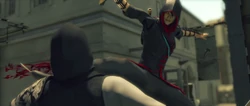The Chinese Brotherhood of Assassins was the Guild of Assassins in China, one of the few branches to have existed for more than a thousand years.
Focusing primarily on dealing with several Templar-backed Chinese Emperors, the Chinese Assassins have often been in difficult positions, as the Chinese Templars held the majority of power in China on numerous occasions.
In 1524, the Chinese Assassins were almost completely rooted out through a ruthless purge by the Jiajing Emperor, with the remaining Assassins fleeing China altogether, seeking support from other branches in the Assassin Order.
History
Qin dynasty
During the 3rd century BCE, Emperor Qin Shi Huang, supported by the Templars, unified China under his banner and became the first Emperor of Imperial China, starting the Qin dynasty.[1]
However, in 210 BCE, the Assassin Wei Yu killed the tyrant Emperor with a spear, making Wei Yu one of the most renowned members of the Order.[2]
Song dynasty
During the Song dynasty, Zhang Zhi was recruited into the Chinese Brotherhood. In 1259, her father died saving a fortress from a Mongol assault, and Zhang found his body with other corpses. Kang, her father's Mentor, completed her training despite his doubts about her motives. She later infiltrated the Mongol camp and assassinated Möngke Khan.[3]
Ming dynasty
Yongle's purge

Li Tong and an apprentice escaping the purge
By the 15th century, the Chinese Assassins were led by the teacher Fang Xiaoru. In 1402, the Imperial throne was usurped by the Yongle Emperor, supported by the Templars. Under Yongle's rule, thousands of Assassins were rounded up and executed, including Fang Xiaoru. However, a young female Assassin named Li Tong and an Assassin apprentice were able to escape the purge with an Apple of Eden. This caused Li to devote herself to protecting the Apple and keeping it out of Yongle's hands.[4]
In 1424, while Yongle attempted to suppress a rebellion near the Gobi Desert, Li Tong slipped into Yongle's tent and killed the Emperor.[4]
Fall of the Brotherhood
In 1521, after the death of the Zhengde Emperor, and while the administration was preoccupied with looking for an heir, the Assassins infiltrated the Imperial Palace to rescue the Emperor's concubines. In the process, they recruited a young woman named Shao Jun into the Brotherhood, though many concubines had to be left behind.[1]
In 1524, the new Emperor, Emperor Jiajing, again aided by the Templars, nearly destroyed the Assassin Order in China, determined to eliminate all groups who opposed him.[1] This determination led him to execute all of Zhengde's former concubines, their death by lingchi discovered by Shao Jun and her Mentor on the Assassins' second rescue attempt.[5]

Shao Jun and Ezio Auditore, before her departure
The remaining Assassins traveled West in groups, with Shao Jun and her Mentor heading for Italy. In Venice, they were intercepted by Jiajing's men, and her Mentor was killed. Eventually continuing on to Florence, Shao Jun met Ezio Auditore da Firenze, the retired leader of the Italian Assassins and a former Mentor in the Assassin Order. Despite her desire to learn from him, Ezio, then 65 years old, was unwilling to help Jun at first.[5]
Upon discovering the fate of the Chinese Assassins however, Ezio decided to support her, eventually fighting off more of Jiajing's assailants in Ezio's home. With Ezio's knowledge and a secret box to only be used in times of dire need, Shao Jun started to make her way back to China, determined to rebuild the Order's presence there.[5]
Reformation

A Chinese Assassin reporting to the Mentor Shao Jun
Shao Jun's quest was a success; she managed to kill the Eight Tigers, including their Master, Zhang Yong, in 1532. Her Mentor, Wang Yangming, was killed by Yong three years prior. They also succeeded in assassinating Emperor Jiajing by giving him a false elixir of life.[6] By 1582, her Brotherhood was in contact with their Japanese brothers, with Liu Yan being present in the country with the task of taking Oda Nobunaga's Sword of Eden to safety, following Nobunaga's assassination by Yamauchi Taka.[7]
By the early 18th century, the Chinese Brotherhood was still strong, as Ah Tabai, Mentor of the West Indies Brotherhood, possessed contacts as far as China. [8]
Modern times
By 2015, at least one Assassin cell operated in China. That year, they were aided by the Japanese Assassins, including Kiyoshi Takakura, who were sent by Japanese Mentor Saeko Mochizuki, in their search for Álvaro Gramática's secret laboratory in which he planned to replicate an Isu's body with the help of the Shroud.[9]
In 2016, the Chinese Assassin Yanmei was ordered by Assassin leader Gavin Banks to assist another Assassin, Griffin, and the teenagers Natalya Aliyev, David Collins and Javier Mondragón in finding the Tomb of Möngke Khan and retrieving a prong of the Trident of Eden. However, Yanmei was ultimately killed by the Templar Isaiah after he recovered the fear prong and used its power against everyone, killing her when she tried to attack him.[10]
In February 2017, an Assassin cell led by Barindra Mitra assisted Charlotte de la Cruz in her efforts to gather informations about the Templars' Phoenix Project. Infiltrating an office of Abstergo in a skyscraper in Hong Kong, which had in fact been abandoned by the Templars, the Assassins were ambushed by an unidentified group. Barindra and her cell were all killed with only de la Cruz and the tech expert, Guernica Moneo, escaping.[11]
Techniques
The Chinese Assassins used Hidden Blades,[6] and in some instances, wore bracers equipped with needles. Being located close to the hands, the Assassins could quickly throw multiple needles in a row.[5]

Shao Jun using her concealed blade
Uncomfortable with the traditional Hidden Blade, Shao Jun developed the Hidden Footblade, which came to good use with Chinese fighting techniques, that involved the use of the legs and feet more often.[6]
The Chinese Assassins would eventually use rope darts created by Shao Jun after her return to China,[6] for which she became renowned.[12]
Appearance
The Chinese Assassins' robes did not always meet normal Assassin customs. On many occasions, they wore ordinary Chinese clothing, making their affiliation hardly recognizable.[2][4]
It was only during the height of the Renaissance period in Europe that the Chinese Assassins ordinarily wore hoods; despite this, the Assassins did not necessarily wear white, as Shao Jun wore black Assassin robes.[5]
Members
- Fang Xiaoru
- Shao Jun
- Li Tong
- Liu Yan
- Barindra Mitra (Membership uncertain)
- Kang
- Wang Yangming
- Wei Yu
- Yanmei
- Zhang Zhi's father
- Zhang Zhi
- Zhu Jiuyuan
Allies and puppets
Ming dynasty
21st Century
References
- ↑ 1.0 1.1 1.2 Assassin's Creed Encyclopedia
- ↑ 2.0 2.1 Assassin's Creed II
- ↑ Assassin's Creed: Last Descendants - Tomb of the Khan
- ↑ 4.0 4.1 4.2 Assassin's Creed: Revelations – Discover Your Legacy
- ↑ 5.0 5.1 5.2 5.3 5.4 Assassin's Creed: Embers
- ↑ 6.0 6.1 6.2 6.3 Assassin's Creed Chronicles: China
- ↑ Assassin's Creed: Memories
- ↑ Assassin's Creed IV: Black Flag
- ↑ Assassin's Creed: Syndicate – Database: Assassin Intel 4
- ↑ Assassin's Creed: Last Descendants - Tomb of the Khan
- ↑ Assassin's Creed: Uprising – Volume 1
- ↑ Assassin's Creed III
| |||||||||||||||||||||||||||||||
| ||||||||||||||||||||||||||||
| |||||||||||||||||||||||||||||||


